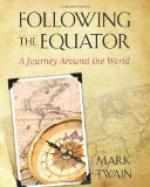All the plain around that region is spread over, a foot deep, with blue rock, placed there by the Company, and looks like a plowed field. Exposure for a length of time make the rock easier to work than it is when it comes out of the mine. If mining should cease now, the supply of rock spread over those fields would furnish the usual 8,000 car-loads per day to the separating works during three years. The fields are fenced and watched; and at night they are under the constant inspection of lofty electric searchlight. They contain fifty or sixty million dollars’ worth’ of diamonds, and there is an abundance of enterprising thieves around.
In the dirt of the Kimberley streets there is much hidden wealth. Some time ago the people were granted the privilege of a free wash-up. There was a general rush, the work was done with thoroughness, and a good harvest of diamonds was gathered.
The deep mining is done by natives. There are many hundreds of them. They live in quarters built around the inside of a great compound. They are a jolly and good-natured lot, and accommodating. They performed a war-dance for us, which was the wildest exhibition I have ever seen. They are not allowed outside of the compound during their term of service three months, I think it, is, as a rule. They go down the shaft, stand their watch, come up again, are searched, and go to bed or to their amusements in the compound; and this routine they repeat, day in and day out.
It is thought that they do not now steal many diamonds successfully. They used to swallow them, and find other ways of concealing them, but the white man found ways of beating their various games. One man cut his leg and shoved a diamond into the wound, but even that project did not succeed. When they find a fine large diamond they are more likely to report it than to steal it, for in the former case they get a reward, and in the latter they are quite apt to merely get into trouble. Some years ago, in a mine not owned by the De Beers, a black found what has been claimed to be the largest diamond known to the world’s history; and, as a reward he was released from service and given a blanket, a horse, and five hundred dollars. It made him a Vanderbilt. He could buy four wives, and have money left. Four wives are an ample support for a native. With four wives he is wholly independent, and need never do a stroke of work again.
That great diamond weighs 97l carats. Some say it is as big as a piece of alum, others say it is as large as a bite of rock candy, but the best authorities agree that it is almost exactly the size of a chunk of ice. But those details are not important; and in my opinion not trustworthy. It has a flaw in it, otherwise it would be of incredible value. As it is, it is held to be worth $2,000,000. After cutting it ought to be worth from $5,000,000 to $8,000,000, therefore persons desiring to save money should buy it now. It is owned by a syndicate, and apparently there is no satisfactory market for it. It is earning nothing; it is eating its head off. Up to this time it has made nobody rich but the native who found it.




